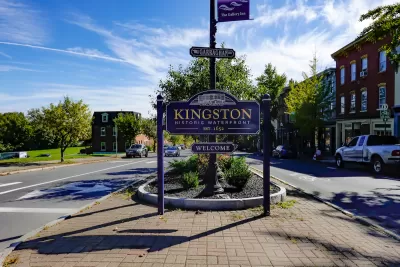Kingston recently adopted a form-based code, taking the rare step to entirely replace its old zoning code with form-based standards while also repealing parking requirements and allowing accessory dwelling units and missing middle housing.

The city of Kingston, New York, located north of New York City along the Hudson River, adopted a new form-based code earlier this month. According to local news reports, the form-based code is intended to mitigate the growing cost of housing in the city by allowing accessory dwelling units and new opportunities for infill development.
According to an article by Phillip Pantuso, Kingston’s new code is notable for replacing its entire zoning code with a new form-based code—most cities who have applied form-based codes do so only in certain nieghborhoods or along specific streets.
“The new zoning code was developed over a three-year period with the consulting firm Dover, Kohl & Partners and included regular community input organized in part by the local advocacy group Kingston Code Reform Advocates,” reports Pantuso.
Among the changes accomplished by Kingston’s new form-based zoning code are the end of minimum parking requirements, the legalization of missing middle housing, corner stores, and accessory dwelling units, and a new, “streamlined” development approval process.
Here is how Pantuso describes form-based codes:
Form-based codes address the relationship between building facades and public space, the form and mass of buildings in relation to one another, and the scale and types of streets and blocks, according to the Form-Based Codes Institute, a nonprofit focused on creating healthy communities. The goal is to emphasize creating cohesive and visually appealing communities that promote walkability and mixed-use development.
FULL STORY: Kingston passes form-based zoning code to aid affordable housing

Study: Maui’s Plan to Convert Vacation Rentals to Long-Term Housing Could Cause Nearly $1 Billion Economic Loss
The plan would reduce visitor accommodation by 25,% resulting in 1,900 jobs lost.

North Texas Transit Leaders Tout Benefits of TOD for Growing Region
At a summit focused on transit-oriented development, policymakers discussed how North Texas’ expanded light rail system can serve as a tool for economic growth.

Using Old Oil and Gas Wells for Green Energy Storage
Penn State researchers have found that repurposing abandoned oil and gas wells for geothermal-assisted compressed-air energy storage can boost efficiency, reduce environmental risks, and support clean energy and job transitions.

Santa Barbara Could Build Housing on County Land
County supervisors moved forward a proposal to build workforce housing on two county-owned parcels.

San Mateo Formally Opposes Freeway Project
The city council will send a letter to Caltrans urging the agency to reconsider a plan to expand the 101 through the city of San Mateo.

A Bronx Community Fights to Have its Voice Heard
After organizing and giving input for decades, the community around the Kingsbridge Armory might actually see it redeveloped — and they want to continue to have a say in how it goes.
Urban Design for Planners 1: Software Tools
This six-course series explores essential urban design concepts using open source software and equips planners with the tools they need to participate fully in the urban design process.
Planning for Universal Design
Learn the tools for implementing Universal Design in planning regulations.
Ascent Environmental
Borough of Carlisle
Institute for Housing and Urban Development Studies (IHS)
City of Grandview
Harvard GSD Executive Education
Toledo-Lucas County Plan Commissions
Salt Lake City
NYU Wagner Graduate School of Public Service





























